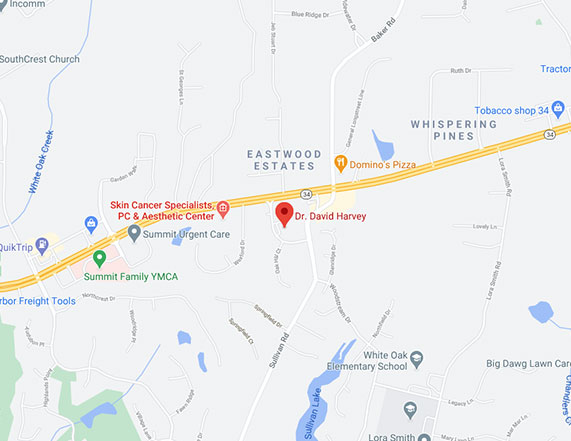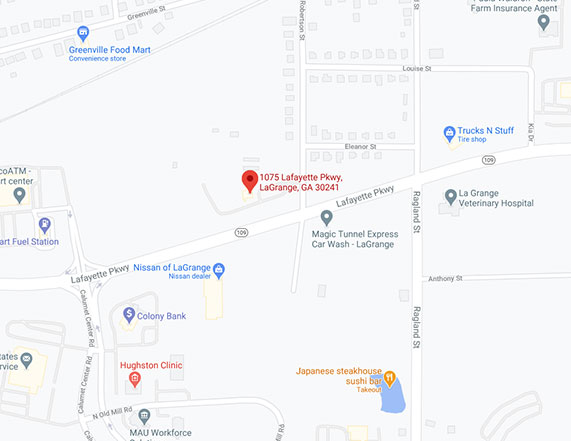Conveniently located to serve Newnan, Peachtree City and LaGrange
Click here to jump to:
Newnan Common Skin Growths
The following is a brief overview of some of the common skin growths that we see in our Newnan and LaGrange offices. This is meant to be used as an educational resource for our patients only.
*No republication or reuse of this content is permitted without the expressed written consent of Surgical & Cosmetic Dermatology, PC.
ACTINIC KERATOSIS
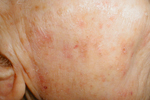
– a skin growth that occurs as a result of chronic cumulative sun exposure. It usually presents as a scaling, sandpaper rough spot(s) which does not heal and is often tender. It is estimated that up to 5% of these lesions can develop into squamous cell carcinoma.
ANGIOFIBROMA
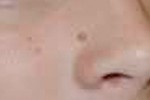
– a benign skin growth, referred to as a fibrous papule, which is often found on the nose. Lesions can be cosmetically removed with a shave removal or laser. They are often confused with malignant basal cell carcinoma.
ATYPICAL NEVUS (DYSPLASTIC NEVUS)
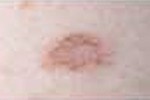
– refers to a benign pigmented growth that has the potential to develop into or serve as a warning sign for the development of malignant melanoma. Atypical moles can be graded into mild, moderate, or severe subtypes. Although technically benign, we usually recommend that moderate and severe atypical nevi be removed.
Related
Content
Patient
Review
“I was one of the unlucky ones who got skin cancer. Luckily, it was caught early. Dr. Harvey treated me like family, and I am glad we found such a good dermatologist in this area.”
by Anonymous
BLUE NEVUS
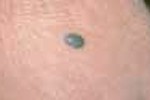
– an acquired benign, firm dark blue to gray skin growth that appears blue because of the accumulation of dark pigment in the deeper portions of the skin. These growths can be subdivided into common, cellular, and combined subtypes. Blue nevi are sometimes removed due to their close resemblance to malignant melanoma lesions.
BECKER’S NEVUS
– an acquired benign unilateral, hairy brown patch of skin that usually occurs on the body. It is commonly found on the shoulders and most often occurs in adolescent males. Becker’s nevi can be treated with laser surgery.
CAFÉ’ AU LAIT SPOT
– well-circumscribed tan spots that range from 1 to 20 cm in diameter. These tend to occur over the face, arms, or legs and are benign. We can remove these lesions using our Nd Yag laser. The spots are brown because of an increase in the number of pigment cells in the skin.
CHERRY ANGIOMA
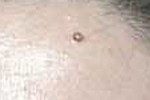
– benign growths which are commonly found on the skin. Cherry Angiomas are also referred to as “Cherry Moles” or Campbell De Morgan spots. They are comprised of small capillaries and can be treated using pulse dye or KTP lasers.
DERMATOFIBROMA
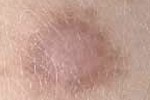
– a firm, benign bump on the skin with a positive “dimple” sign. Often these growths result from an insect bite reaction, trauma, or an ingrown hair follicle. Patients often note these growths when shaving or bathing. Unless the growth is painful or inflamed, no treatment is usually needed.
DIGITAL MUCOUS CYST
– benign cysts that usually occur on the distal finger joints and result from connective tissue degeneration or trauma. Mucous Cysts contain a clear viscous fluid. They may form in an arthritic joint and sometimes an orthopedic evaluation and X–ray is necessary. Treatment is often carried out with surgical excision and electrocautery.
ECCRINE/APOCRINE HYDROCYSTOMA
– these growths are derived from either sweat glands (ECCRINE) or odor glands (APOCRINE). Lesions are usually solitary and may increase in size. Apocrine hydrocystomas usually have a bluish hue and can be confused with basal cell cancer. Because of the underlying concern for malignancy, we usually recommend that these growths be surgically removed.
EPIDERMOID CYST
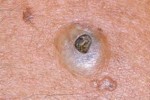
– this growth is the most common skin cyst and presents as a firm round bump with a central pore White to yellow cheesy exudates can be expressed from these pores. Epidermoid cysts can occur on the face, back, or legs. When inflamed, they can be surgically removed.
LIPOMA

– a benign fatty growth that presents as a soft, moveable swelling underneath the skin. Some lipomas can enlarge to a significant size. They often occur on the neck, trunk, and extremities. Removal is carried out with simple surgical excision or liposuction.
LICHEN SIMPLEX (PRURIGO NODULE)
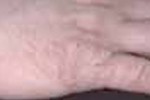
– refers to a localized, benign growth of the skin which occurs in response to trauma and repeated scratching. The skin becomes extremely sensitive to the touch due to a proliferation of nerve tissue in the skin. Stress, anxiety, and friction are exacerbating factors. Treatment involves the interruption of the “itch-scratch” cycle and corticosteroid creams or injections.
MILIA
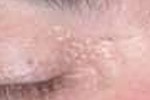
– small white to yellow bumps that can occur over the eyelids, cheek, or forehead areas. Lesions are removed through an extraction technique or warm compresses. Some of these growths resolve spontaneously.
MOLLUSCUM CONTAGIOSUM
– refers to a benign growth(s) that is caused by a poxvirus infection. These growths are often seen in young children and usually resolve spontaneously. Molluscum lesions have a central “depression” and are often confused with warts. Treatments include duct tape application, “nicking” the growth with a fine needle, topical acids, or oral cimetidine.
MUCOCELE
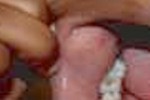
– a single dome-shaped translucent blue-to-white cyst that contains clear viscous fluid. Growths are usually located on the inner surface of the lower lip or the inside floor of the mouth. Mucoceles usually result from ruptured or obstructed oral salivary glands. Treatment is usually carried out with surgical removal.
NEUROFIBROMA
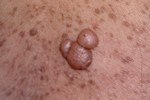
– refers to benign skin growth that derives from nerve and fibrous tissue. When multiple lesions are present, one must consider the diagnosis of Neurofibromatosis, an inherited disorder. Growths are sometimes removed due to disfigurement or pain.
NEVUS (COMPOUND)
– benign mole which is symmetrical and raised. Compound nevi usually develop in the early years. Some nevi lose their pigment or become smaller with time. Unless they are inflamed or irritated, their removal is usually considered cosmetic.
NEVUS (CONGENITAL)
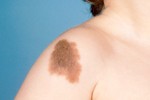
– a birthmark that can occur in up to 1 percent of all infants. Congenital nevi are defined by their size, i.e., small (20 cm). The risk of melanoma development increases with the size of the growth, e.g., up to a 6% malignancy rate can be seen in large congenital nevi.
NEVUS (HALO)
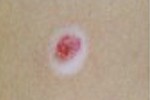
– refers to a benign mole that is encircled by a rim of white skin pigment. Halo nevi occur within the first 30 years of life. They can be associated with vitiligo and, rarely, malignant melanoma. No treatment is needed unless the mole “changes”.
NEVUS (INTRADERMAL)
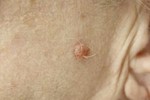
– Intradermal nevi are also benign raised growths but, unlike compound nevi, they do not usually have pigment and appear flesh-toned in color. Unless they are inflamed or irritated, their removal is usually considered cosmetic.
NEVUS (JUNCTIONAL)
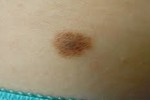
– benign skin growth which is symmetrical and flat. Junctional nevi develop in the early growth years and may lose their pigment with time. Pregnancy can have the opposite effect and the growths may become darker and larger. Lesions can be removed with a laser. They should be monitored for itching, bleeding, or a change in color or size.
NEVUS SPILUS
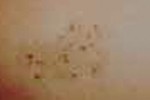
– a benign growth consisting of two components. 1. The dark spots or “Spilus” refers to the benign mole or nevus component while the 2. larger tan area is comprised of a lentigo simplex. This growth is seen in 3% of all patients. Though melanoma can rarely occur in a nevus spilus, no treatment is usually required. Lesions should be monitored for change.
PILOMATRICOMA

– refers to a benign tumor commonly found on the face, scalp, or trunk. These growths are often hard nodules and are sometimes confused with cysts. Pilomatricomas derive from hair matrix cells. Sometimes they can be associated with disorders such as hair loss, Raynaud’s phenomenon, and myotonic dystrophy.
PYOGENIC GRANULOMA
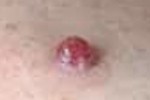
– a rapidly developing papule that bleeds easily and is friable. Usually, these growths form after a trauma such as a skin burn or insect bite. Pregnancy can also promote the development of these growths. Treatment can be carried out with gentle cautery, shave removal, and/or corticosteroid injections.
SEBACEOUS HYPERPLASIA
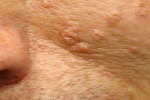
– this growth is seen in patients with oily skin. Lesions are reminiscent of round “doughnuts” with a central depression and occur where oil gland numbers are in excess. They often develop over the forehead, nose, and cheek areas. Lesions can be removed with a CO2 laser, chemical peels, photodynamic therapy, or gentle cautery.
SEBORRHEIC KERATOSIS
– this growth is perhaps the most commonly seen in our practice. Lesions are inherited and do not usually form until the age of 30. SKs may be few or multiple. They can sometimes be confused with malignant melanoma. Removal is completed with shave removal and is covered by insurance when they are actively inflamed, enlarging, or painful.
SKIN TAGS
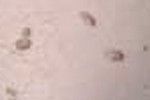
– soft polyp-like growths which form where friction or rubbing occurs. They are often seen in areas such as the neck, underarms, groin, and breasts. Skin tags can become tender or inflamed after trauma. Removal can be carried out using light electrocautery or gradle scissor removal. Their removal is usually considered cosmetic.
SOLAR LENTIGOS
– (liver spots, age spots, “wisdom spots”)-flat tan brown spots that usually occur on the hands and face. They form by the sun’s stimulation of pigment in the skin. Solar lentigos can sometimes evolve into seborrheic keratosis. We can readily remove these growths using laser surgery.
SPIDER ANGIOMAS
– are usually found on the face and trunk and consist of blood vessels that radiate from a central arteriole. Lesions can be treated using laser surgery or gentle cautery. Spider Angiomas can enlarge or become more numerous with liver disease and/or pregnancy.
STUCCO KERATOSES
– refer to small white warty growths on the lower extremities that resemble stucco. They appear with a higher frequency in males; however, they are not inherited genetically. Usually, multiple lesions are found.
SYRINGOMA
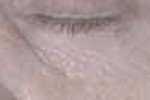
– these benign growths develop from sweat glands. Lesions can occur around the eyes, face, chest, and groin. Though syringomas are disfiguring, they can be removed with CO2 laser or light cautery.
TELANGIECTASIA
– dilated small blood vessels, usually found on the face, which can be associated with rosacea or other systemic disorders. Lesions can increase in size due to heat, estrogen intake, and alcohol ingestion. They can be cosmetically treated with laser and/or electrocautery.
VENOUS LAKE
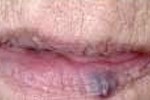
– dark blue-to-purple compressible papules caused by the dilation of small veins. They are easily compressed and tend to occur on sun-exposed skin, e.g., the ears and lips of elderly patients. Although venous lakes are benign, they can mimic skin cancer in certain instances.
WART
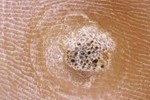
– a benign growth that is caused by a papillomavirus infection. Treatment can be difficult and may require laser, duct tape or medications which boost the immune system e.g., cimetidine
WEN CYST
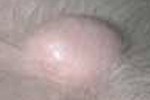
– the second most common cyst that derives from the hair follicle. Overlying hair growth is normal. These lesions are often found on the scalp and present more commonly in women. Treatment can be carried out with simple surgical excision.
XANTHELASMA
– yellow plaques that are found on the skin surface of the upper and/or lower eyelids. They are caused by tiny deposits of fat in the skin and can be associated with abnormal blood fat levels. They can be treated with surgical excision or laser.










